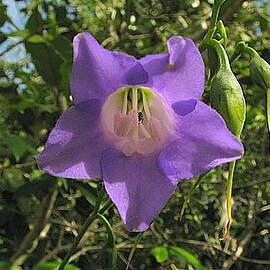Herbs, mostly annuals, rarely suffrutescent; the stems usually simple, erect, tetragonal and often slightly winged. Leaves sessile to sbort-petiolate, amlplexi-eaul; the lamina generally ovate, acute to acuminate at the base, membra-nous to subcoriaeeous, the costa prominent. Inflorescences of terminal or axillary, simple or compound dichasia, pedunculate. Flowers 5-mlerous, white, green-ish, yellow, rose or bluish, slightly zygomorphic, bracteate; calyx cupuliform to campanulate, the lobes imbricate, carinate; corolla infundibular, the tube gibbous, the lobes erect to slightly flaring; stamens 5, included to shortly ex- serted, the filaments adnate to the lower half of the corolla tube, the anthers usually reflexed, sagittate at base; ovary 2-locular (1-locular with much intrud-ing placentae), sessile, the style filiform, persistent, the stigma bilobate. Cap-sules surrounded by the marcescent calyx and corolla, generally ovoid, septi-cidally 2-valvate; seeds tiny, variously angulate, the testa often reticulate. Pollen grains united in tetrahedral tetrads, 52-77 /i; single grains 3-colporate (3-colpate, 3-porate), the concurrent colpi of two contiguous grains ca. 15 X 5 au, the diameter of apocolpia 25-30 /,; exine 2-4 Mu thick at the distal poles, 6-10 M at equator; sexine thicker than nexine, reticulate, heterobrochate, differentiated into a coarsely reticulate, ? equatorial zone with lumina 0.5-9 Mi in diameter, the muri 1-5 M wide, unevenly thickened, occasionally fragmented into ? rounded processes, and for the rest a more delicate reticulum with lumina 0.5-2-in diameter, the muri 0.5-1.5 Mi wide, occasionally not connected laterally, of a pilum or clava-like shape; nexine smooth or granular (C. alatus).
More
Erect herbs (rarely prostrate in C. purpurascens) to subshrubs. Leaves sessile to shortly petiolate, petioles 0.2-2 cm long; secondary veins 2-4(-6). Inflorescences terminal cymes, with 1-2 dichasial branching points terminating in 2 or more monochasial branches; bracts and bracteoles scale-like (sometimes leaf-like when subtending most basal flower). Flowers pedicellate, 5-merous, zygomorphic; calyx fused for 1/6-4/5 of total length, coriaceous, campanulate, lobes with thickened, glandular dorsal area, circular, ovate, elliptic to obovate, not winged or keeled (small wings present in C. hamatus), (upward-facing hook protruding from apex of glandular area in C. hamatus), apex obtuse; corolla bud apex rounded; corolla fused for 3/5-6/7 of total length, thin, campanulate, funnel-shaped, tubular to salver-shaped, 18-87 mm long; androecium zygomorphic with stamens and style bent toward bottom of corolla mouth (in C. pterocaulis stamens and style are clustered together in corolla throat); stamens inserted near base of corolla at 1/6-5/8 of corolla tube length (just above midpoint in C. grandiflorus), of subequal to unequal length, filament base without specialized structures (in C. grandiflorus staminal gaps sometimes present and in C. hamatus corona present), anthers elliptic to slightly ovate, obovate, or oblong, with apical sterile appendage, pollen in tetrads (polyads in C. purpurascens); pistil with nectary disk; stigma bilamellate. Fruit a capsule, with persistent calyx and persistent, partly persistent, or deciduous corolla; seeds angular-cuboidal, 0.1-0.6 mm in diam., testa cells dome-like and/or concave with or without band-like thickenings.

